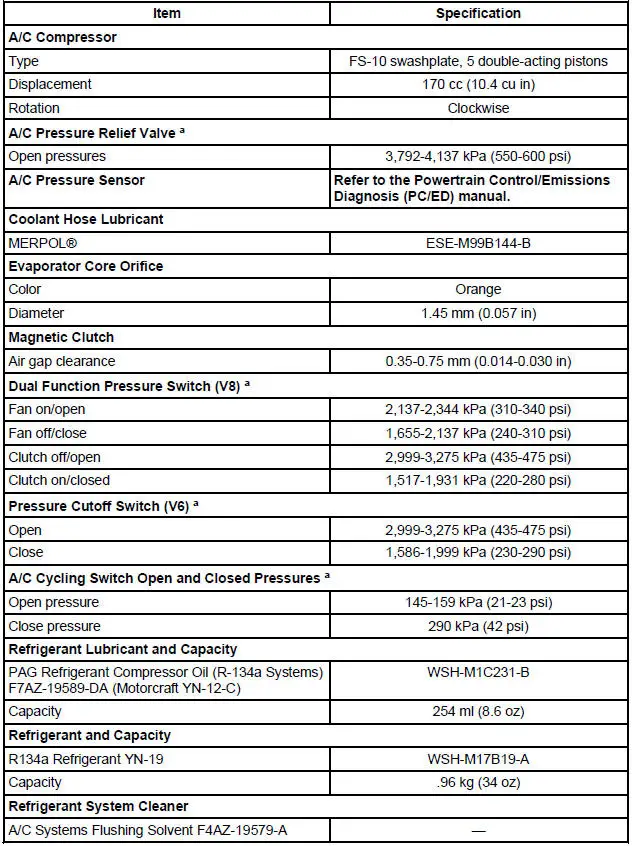Ford Mustang (1999-2004) Service Manual: Climate Control System - General Information
General Specifications

a - Manifold gauge set pressures may vary slightly depending on the distance between the service gauge port valve and the A/C pressure relief valve, the A/C cycling switch, the pressure cutoff switch (V6), and the dual function pressure switch (V8) location.
Torque Specifications

- Climate Control System (Description and Operation)
- Climate Control System (Diagnosis and Testing)
- Air Conditioning (A/C) System Check - Retail Procedure
- Spring Lock Coupling
- Heater Hose Coupling
- Air Conditioning Line (Peanut) Fitting
- Refrigerant System Tests
- Manifold Gauge Set Connection
- Electronic Leak Detection
- Tracer Dye Leak Detection
- Air Conditioning (A/C) System Flushing
- Air Conditioning (A/C) System Recovery, Evacuation and Charging
- Refrigerant System Filtering Following Air Conditioning (A/C) Component Installation
- Refrigerant Oil Adding
- Inspection and Assembly Requirements - Following an A/C Compressor Failure
- Refrigerant Identification Testing
- Contaminated Refrigerant Handling
- Vacuum Hose Repair - Mini-Tube
 Climate Control System (Description and Operation)
Climate Control System (Description and Operation)
WARNING: To avoid accidental deployment and possible injury, the air
bag system
backup power supply must be depleted before repairing any climate control
components. To
deplete the backup power supp ...
Other materials:
Lamp Assembly - Rear
Removal
1. Position the luggage compartment trim aside.
Remove the two retainers.
2. Remove the four rear lamp nuts.
3. Remove the rear lamp assembly, disconnect the electrical connectors and
replace the bulbs if
necessary.
Installation
1. To ins ...
Instrument Cluster (Description and Operation)
The instrument cluster (10849) consists of the following components:
Instrument Cluster-Base 3.8L Engine
Instrument Cluster-Base 4.6L Engine
Instrument Cluster-Cobra
...
Front Bumper
Special Tool(s)
Heavy-Duty Riveter
501-D011 (D80L-23200-A)
Removal and Installation
All vehicles except Cobra
1. Remove the front bumper cover. For additional information, refer to Front
Bumper Cover in this
section.
Cobra
2. Remove the charge ...

